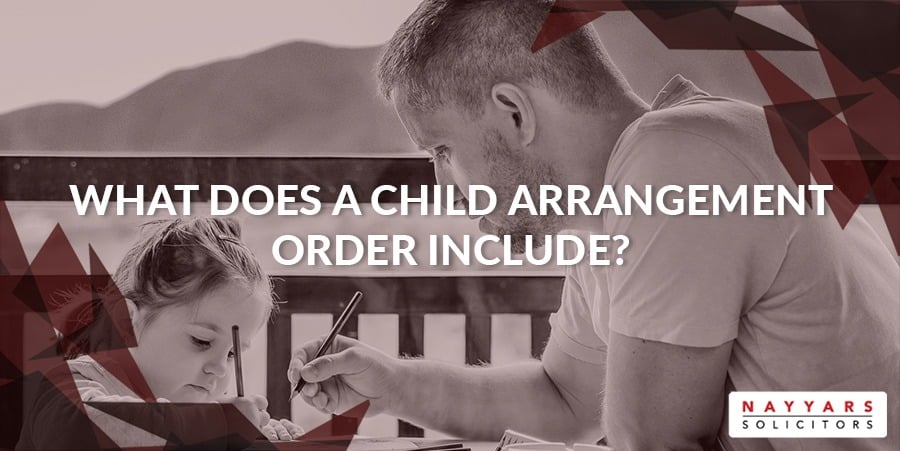LAW SOCIETY EXCELLENCE AWARDS 2019 WINNER!
What Does a Child Arrangement Order Include?

When a relationship breaks down, it can be difficult for two parents to agree on who gets custody of the children. Unsurprisingly, this can lead to unwanted stress and tension and can result in an environment that is not good for you or your children.
In these situations, it can be necessary to ask the court to break the deadlock and decide on a child’s living and/or contact arrangements. This can be done by applying for a Child Arrangement Order (CAO).
A CAO is a legal agreement between the court and parents or guardians and determines what is best for the child. Since the best interests of the child are always the priority, the court has wide-ranging powers when it comes to what should be included in a CAO.
Therefore, when it comes to applying for a CAO, there is no guarantee that you will get the exact outcome you were looking for. For that reason, you should always seek the help of a professional solicitor before making an application.
What Do Child Arrangement Orders Include?
What is Best for the Child

As we touched up, a CAO is not about what is best for you. Its only priority is what is best for the child. As such, an officer from the Children and Family Court Advisory and Support Service (CAFCASS) is regularly assigned to spend time with your family and provide a report and recommendations.
When speaking with CAFCASS, it is important to provide your full cooperation, as any outstanding safeguarding information could result in the court adjourning at your first hearing and the process being delayed.
The Child’s Living Arrangements
One of the most common reasons for applying for a CAO is to determine who your child or children live with. In the past, the idea of determining a primary and secondary carer was common. However, the courts are now moving away from this frame of mind.
Instead, the courts are now trying to promote a sense of equality among both parents. So, alongside deciding your child’s permanent residence, a CAO often also includes details about where and when a child will spend time with their non-custodial parent or guardian.
The Child’s Contact Arrangements
Along with living arrangements, who a child has contact with and how they do so is another common subject of CAOs.
When it comes to contact arrangements, CAOs can be quite specific and can include orders on how direct and indirect contact is to be conducted. This could include rules on overnight visits, phone and email contact, and even whether contact between a parent/guardian and a child needs to be supervised.
Specific Issues
If you and the child’s other parent or guardian are disagreeing on a specific issue, a CAO can be used to come to a resolution. A specific issue could be anything from what school your child should attend, to whether they should be raised under a particular religion.
Prohibited Steps
If there is a concern that one parent will take an action with the child that the other does not want, a prohibited steps order can be made to stop the action. For example, a prohibited steps order may be used to stop a parent leaving the country with the child.
How to Apply for a Child Arrangement Order?
Who Can Apply?

While the majority of CAOs are requested by parents, it is possible for others to make an application. People who can apply for a CAO without the permission of the court include:
- Parents, guardians or special guardians of the child
- Anyone who has parental responsibility for the child
- Anyone who already has a residence order for the child
- Any spouse or civil partner, so long as the child is part of that family
- Anyone with whom the child has lived with for more than three years
If the list above does not apply to you, that does not mean you can’t apply for a CAO, it just means that you will need to apply to the court for permission first.
What Will the Court Consider?
When it comes to what the court will base its decision on, the following considerations will play a role:
- The wishes and feelings of the child (taking into consideration their age and understanding)
- The physical, emotional and educational needs of the child
- The possible impact on the child if their circumstances change
- The child’s age, sex, background and any characteristics that the court considers relevant
- Harm the child has suffered or is at risk of suffering
- How capable each parent is of meeting the child’s needs
Making an Application to the Court

A Child Arrangement Order is made under Section 8 of the Children Act 1989, and while anyone can apply for one, it is wise to seek the support of an experienced family solicitor. This is for the simple reason that every CAO comes with its own unique complexities that need to be navigated.
Before issuing an application you will most likely need to attend a Mediation Information and Assessment Meeting (MIAM) and invite the other party. Here, a mediator will discuss the dispute and assess whether mediation can be used to resolve the issue.
If mediation is suitable, much of the time and stress needed to apply for a CAO can be avoided. Of course, in some cases, such as in allegations of domestic violence, mediation will not be suitable, and for exceptions like this, you do not need to attend MIAM.
Where mediation is unsuitable or breaks down, you can then make an application to the court, confirming that you either attended MIAM or provided a reason for non-attendance.
Once your application has been issued, the case will be allocated to a judge or magistrate. The application will then be referred to CAFCASS, who, alongside speaking with your family, will also gather relevant information from the local authority and police.
Attending Court Hearings
As part of your application for a CAO, you will need to attend a series of hearings. The number of hearings will vary, depending on the specifics of your case and how much evidence needs to be filed, but there are broadly three stages:
- First Hearing Dispute Resolution Appointment (FHDRA): In this first hearing, all parties (except children) must attend so the points of dispute can be determined and any possible resolutions explored. If an agreement is reached, the judge can make an order, otherwise, the judge will highlight the issues which remain in dispute. Both parties can be ordered to prepare statements on which they will rely on.
- Dispute Resolution Appointment (DRA): If CAFCASS has been ordered to prepare a report, a DRA is scheduled to hear the report. An attempt will then be made to resolve the issues in dispute by hearing evidence from all parties. If an agreement is reached an order can be made. If not, a final hearing is scheduled.
- Final Hearing: The court will consider all relevant evidence that has been submitted and make a decision about the issues in dispute. Both parties and their legal representatives may be asked questions by the court. After this, the court will make an order deciding the issues in dispute.
Conclusion
CAOs have the power to bring stability and clarity to your life, and most importantly, the life of your child. However, with the decision of the court being final, it is important to ensure your application, evidence and overall case is strong.
For that reason, you should always seek professional legal advice before embarking on an application for a CAO. That way you can identify exactly what you want your Child Arrangement Order to include and give yourself the best chance of achieving the right outcome.
So, if you are considering a Child Arrangement Order, speak to Nayyars’ team of family solicitors to find out how we can help you.


